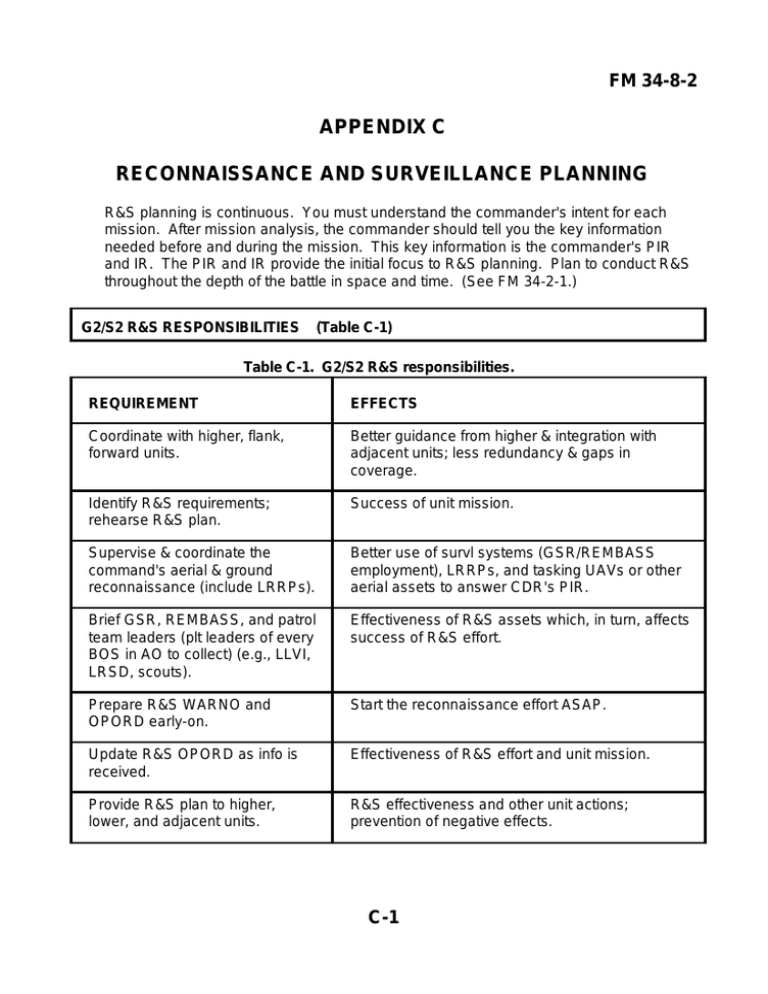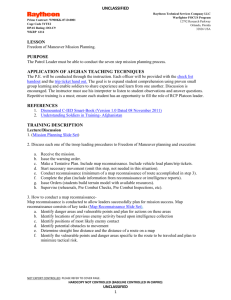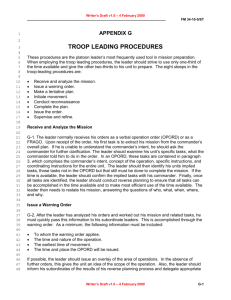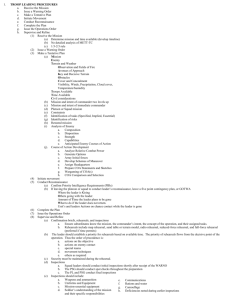APPENDIX C RECONNAISSANCE AND SURVEILLANCE PLANNING FM 34-8-2
advertisement

FM 34-8-2 APPENDIX C RECONNAISSANCE AND SURVEILLANCE PLANNING R&S planning is continuous. You must understand the commander's intent for each mission. After mission analysis, the commander should tell you the key information needed before and during the mission. This key information is the commander's PIR and IR. The PIR and IR provide the initial focus to R&S planning. Plan to conduct R&S throughout the depth of the battle in space and time. (See FM 34-2-1.) G2/S2 R&S RESPONSIBILITIES (Table C-1) Table C-1. G2/S2 R&S responsibilities. REQUIREMENT EFFECTS Coordinate with higher, flank, forward units. Better guidance from higher & integration with adjacent units; less redundancy & gaps in coverage. Identify R&S requirements; rehearse R&S plan. Success of unit mission. Supervise & coordinate the command's aerial & ground reconnaissance (include LRRPs). Better use of survl systems (GSR/REMBASS employment), LRRPs, and tasking UAVs or other aerial assets to answer CDR's PIR. Brief GSR, REMBASS, and patrol team leaders (plt leaders of every BOS in AO to collect) (e.g., LLVI, LRSD, scouts). Effectiveness of R&S assets which, in turn, affects success of R&S effort. Prepare R&S WARNO and OPORD early-on. Start the reconnaissance effort ASAP. Update R&S OPORD as info is received. Effectiveness of R&S effort and unit mission. Provide R&S plan to higher, lower, and adjacent units. R&S effectiveness and other unit actions; prevention of negative effects. C-1 FM 34-8-2 EXAMPLE: The primary R&S planning objective is to task subordinate units (all possible assets; e.g., MI, MP, FA, Signal, Engr, FSB) to cover NAIs important to brigade mission or directed by higher HQ. Subordinate units plan the use of available R&S assets to satisfy taskings from the brigade and their own requirements. They strive to complete their plans quickly (using the 1/3, 2/3 rule) so R&S assets have time to prepare and execute the plan. As soon as they are complete, the subordinate unit plans are consolidated at brigade to form the brigade R&S plan. You now have a draft plan that shows when and in what areas to begin R&S planning. R&S PLANNING PROCESS (Figure C-1) I. PLANNING PROCESS. A. Initial Requirements: 1. 2. 3. 4. 5. Did higher HQ provide tasking requirements? Was the commander's PIR and IR stated and included? Did commander provide R&S intent? Did S2 brief the staff on enemy collection capabilities? Were other staff tasks performed? B. SIR Developed (IPB Driven): 1. Did S2 identify air or ground AA? 2. Did situation and event templates reflect probable or prioritized ECOAs? 3. Was NAI developed in detail? (What is expected? When? Where?) 4. Were collectible indicators at NAIs developed? 5. Were SIR developed from NAIs and indicators? 6. Were reporting requirements developed for priority collection missions to allow the commander time to change plans? C. Possible Collectors Analyzed: 1. Did S2 coordinate with staff, S2, and G2 to identify all available collection assets? 2. Did S2 analyze asset capabilities to develop collection requirements based on range to target, time available, target characteristics, terrain, weather, enemy (obscurant use), and communication? 3. Did S2 analyze collection redundancy (is it necessary)? Figure C-1. R&S planning process. C-2 FM 34-8-2 4. Did staff identify support requirements (communication nets, retransmission, FS, NBC reconnaissance support, logistic support, special equipment support)? 5. Did S2 identify gaps in collection? 6. Did S2 back brief S3 or the commander on R&S concept? 7. Were WARNOs sent to appropriate assets? 8. What were timelines? a. When was mission received? b. What is NLT time for execution? c. When was templating done? d. When was tentative plan made? Back briefed? f. When was initial reporting needed? g. Who was in charge of R&D planning? h. Who was in charge of counterreconnaissance planning? i. What is LTIOV. II. PREPARATION FOR R&S OPERATIONS. A. Specific Collection Instructions: 1. What assets could be available? Used? (See Figure C-4.) a. Scouts. m. GSR. b. Patrols. n. OPs and LPs. c. Forward Observers. o. Signal. d. Armor. p. Antitank. e. Aviation. q. Engineer. f. Infantry. r. Cavalry. g. EW. s. MP. h. REMBASS. t. ADA. i. Chemical. u. SOF. j. UAV. v. Support units. k. Medical. w. GRCS. I. CI teams. x. Interrogation teams. 2. Did the S2 provide detailed instructions to tasked assets? Did the instructions include— a. Who is tasked? b. What to look for? c. Why to look? d. When to look? e. Where to look? f. What you could expect to see? g. How to get there? h. Who to coordinate with? Figure C-1. R&S planning process (continued). C-3 FM 34-8-2 i. Passage of lines and recognition signals? j. Reporting requirements? k. Friendly assets in AO? l. Resupply? m. Obstacles? n. MEDEVAC? o. NBC hazards? 3. Was the collection location appropriate (concealment, collectable)? 4. Were there sufficient control measures included to control assets during mission? 5. Did the S2 request assistance from higher HQ for identified collection gaps? 6. Did the R&S plan cover all collection requirements? 7. Were assets overtasked? 8. Was redundancy appropriate for this mission? B. Coordination: 1. 2. 3. 4. 5. 6. 7. 8. 9. What is format of plan (collection plan, overlay, matrix)? Were direct or indirect fires or jamming coordinated between staff and S2? Was a CI vulnerability assessment made? Was additional equipment (special) planned for? Were communication nets established to meet reporting needs? Were commanders and staff briefed on plan before execution? Did commander or S3 approve final plan? Did assets know specific requirements (PIR and IR)? Was plan disseminated to all involved or with a need to know (FRAGO, overlay)? 10. Was plan sent to higher HQ? C. Asset Internal Coordination: 1. Was equipment checked? 2. Were internal procedures clarified? 3. Did coordination between assets occur? 4. Was mission rehearsed? 5. Was plan developed far enough in advance for assets to prepare or rehearse? 6. Was plan developed in time for higher HQ to review? III. EXECUTION. A. Continuity of R&S and counterreconnaissance operations: Figure C-1. R&S planning process (continued). C-4 FM 34-8-2 1. Did unit plan provide for operations when scout or other R&S assets are inoperable? 2. Did unit SOP provide for operations during briefings, debriefings, or rehearsals? 3. Are unit and leaders cross-trained to facilitate substitutions or replacement of scouts? B. Asset and Unit Response: 1. 2. 3. 4. 5. 6. 7. 8. 9. 10. 11. 12. 13. 14. 15. Did assets depart and set up on time? Did assets use concealment, cover, and camouflage? Were assets able to observe enemy undetected? Was low-level deception used? What were meteorological report requirements? Were enemy locations pinpointed? Was objective reconnoitered? Were obstacles identified and marked? Were routes marked? Did assets submit route/obstacle overlay? Was enemy reconnaissance located? Were counterreconniassance missions performed? Did assets help with C2 during attack? Did assets help direct or control fires? Was terrain reconnoitered (trafficability reported)? C. Reporting: 1. Were reports timely, accurate, and concise? 2. Were assets debriefed? D. Results: 1. Did S2 plot asset reports (track results of plan)? 2. Did S2 identify inadequately tasked or unproductive assets and change tasking (with approval of commander and S3)? 3. Did reports or analysis answer PIR and IR? 4. Was R&S plan updated and recoordinated? 5. Were templates updated? E. Dissemination: 1. 2. 3. 4. 5. Was commander briefed on answer to PIR? Has commander updated PIR? Did units get intelligence based on priority? Did higher HQ get answers to taskings? Did assets receive feedback on level of success? Figure C-1. R&S planning process (continued). C-5 FM 34-8-2 OTHER R&S PLANNING CONSIDERATIONS (Figure C-2) 1. General. a. Combat information is knowledge of the enemy, weather, and terrain. b. R&S collection should answer the commander's PIR and IR. c. Every soldier is an important HUMINT collection asset. 2. Analysis of information collected on PIR and IR is an objective process. 3. Determine requirements: a. Set priorities. Develop SIR and SOR. Do not let the R&S elements decide what answers the commander's PIR. b. Terrain and weather. c. Tactical situation (deep, close, rear). d. Focus the R&S mission. 4. Develop R&S plan based on the principles of reconnaissance: a. Timely information. b. Aggressive reconnaissance. c. Continuous reconnaissance. d. Focus combat power. e. Relevant information (focused on PIR and CCIR). f. Reconnaissance OPSEC. Coordinate with G3/S3 to establish control measures which deconflict and help protect R&S assets on the battlefield. g. Accurate information. h. Complementary with operations. i. Consideration of threat counterreconnaissance threat. j. Destruction of threat reconnaissance elements when detected. k. Plan for CasEvac, resupply, and reconstitution for teams in the field. 5. Identify METT-T. 6. Develop communications plan and reporting schedule. 7. Issue WARNO to R&S asset leaders. 8. Coordinate R&S plan with— a. Commander and commanders of areas in which teams will operate. b. Adjacent and higher G2/S2. Figure C-2. R&S planning considerations. C-6 FM 34-8-2 c. d. e. f. g. h. i. Unit S1/S3/S4. FSO. SIGO. Engineer LNO. ADA LNO. Chemical Officer. G3/S3 to tie R&S plan into the maneuver plan. 9. Brief R&S team leaders and all other R&S assets. 10. Advise higher and lower S2 of R&S plan. 11. Request support from higher headquarters. 12. Write R&S tasks into paragraph 3 of the OPORD. 13. Evaluate reports, review requirements, and identify intelligence gaps. 14. Analyze reports to deny or confirm your templates; then update templates. 15. Ensure combat information is passed immediately to those elements that can react to it. 16. Update the R&S plan based on known intelligence. 17. Plan for future operations. 18. Maximize use of all available assets. Figure C-2. R&S planning considerations (continued). You can now begin adding some detail to the R&S plan. Integrate any requirements from higher HQ. Translate the initial PIR and IR into indicators on which R&S assets can collect. Use the indicators to develop the SIR and SOR. The SIR and SOR ensure assets are collecting specific information that answers the PIR and IR. Once you have a picture of the coverage required for the R&S effort, prioritize the SIR. Assign a high priority to those SIR that, when answered, will provide the greatest amount of intelligence in the shortest amount of time. After you prioritize the SIR, draft the R&S plan and distribute to the appropriate R&S assets. It is critical that you deploy R&S assets early-on and update them as additional information is received. C-7 FM 34-8-2 TOOLS TO TRACK DEPLOYED R&S ASSETS Three methods are used to track deployed R&S assets: Reconnaissance base OPORD (Figure C-3). R&S overlay (Figure C-4). R&S tasking matrix (Figure C-5). Select any method as long as the assets receive clear, specific instructions. Some S2s use all three methods by attaching the R&S overlay and R&S tasking matrix to the reconnaissance order prior to dissemination. When possible, using all three is best because each asset then has a graphic, a matrix, and a written set of instructions. RECONNAISSANCE ORDER: The reconnaissance order is the narrative instructions for deployed assets. Figure C-3 is an example of a brigade reconnaissance order. RECONNAISSANCE ORDER 1. SITUATION. a. Enemy forces. b. Friendly forces. c. Attachments and detachments. d. Assumptions (OPLAN only). 2. MISSION. Expressed as task and purpose derived from planning process. Clearly stated reconnaissance objectives. 3. EXECUTION. Commander's intent, derived during planning process: a. Concept of Operation. State how reconnaissance assets are operating in relation to the parent organization. This scheme must identify if the reconnaissance force is infiltrating or penetrating the enemy's security forces (or both) and how this will occur. Figure C-3. Example of a brigade reconnaissance OPORD. C-8 FM 34-8-2 (1) Manuever. (2) FS. (Refer to FS annex if required.) (a) Scheme of fires that specifies what fires are available and how to get them. (b) Engagement criteria. (c) Scheduled fires in support of insertions and extractions. (3) Mobility and survivability. (4) Air defense. (5) C2W. b. Tasks to maneuver units. [List all units from task organization into subparagraphs, and only unique items for those units; all other tasks go into d below.] For each of the elements in the reconnaissance force, state the following: (1) How to get there. (2) Where to look (NAI for static targets). (3) What to look for. (4) When to look for it. (5) Plan to maintain contact with moving target. (6) What equipment to bring. (7) How (what communications systems, how often) to report. (8) To whom to report: (a) Brigade reconnaissance teams. (b) Task forces. (c) MI company (EW, UAV, other). (d) ADA battery. (e) Engineer battalion. (f) FA battalion. (g) Chemical company. (h) MP platoon. (i) Signal company. (j) FSB. c. Tasks to combat support units (if applicable). (1) Fires (or refer to FS annex). (a) Air support. (b) Chemical support. (c) FA support. (2) Mobility and survivability. (Refer to mobility and survivability annex if required.) Figure C-3. Example of a brigade reconnaissance OPORD (continued). C-9 FM 34-8-2 (3) (4) d. Air defense. (Refer to air defense annex if required.) C2W. (Refer to C2W annex if required; address applicable subcomponents of C2W: deception, EW, psychological warfare, UAVs.) Coordinating instructions. (1) Time or condition when OPORD or OPLAN becomes effective. (2) EEFI. (a) PIR. (b) EEFI. (c) FFIR. (3) Risk reduction control measures. (4) Environmental considerations. (5) Any additional coordinating instructions. (a) LD or defend NLT . (b) MOPP level. (c) Rally points, alternate positions. (d) Rehearsal time, type, location. (e) Extraction plan. (f) PZ and LZ. (g) Fratricide avoidance measures. (h) ROE and actions on contact. (i) IHL. 4. SERVICE SUPPORT. State the concept of logistic support. a. Support concept. b. Material and services (resupply location or time and days of supply, emergency resupply, vehicle evacuation). c. Medical evacuation (CasEvac plan). d. Personnel (reconstitution plan). e. Civil-military cooperation. NA. f. Miscellaneous. 5. COMMAND AND SIGNAL. a. Command (C2 structure, report plan). b. Signal (nets used, retransmission or relay plan). Figure C-3. Example of a brigade reconnaissance OPORD (continued) . C-10 FM 34-8-2 R&S OVERLAY: The R&S overlay is the R&S plan in graphic format. Its purpose is to show exactly where and when R&S assets are operating. Use FM 101-5-1 for overlay graphics and symbols. Due to various R&S operational techniques and the unique nature of some SASO missions, you will need to construct some new graphics and explain them in your legend (Figure C-4). The R&S overlay has two parts: (1) The graphic display of deployed or planned deployment of R&S assets, and (2) The marginal data consisting of the legend, administrative data, specific instructions to each asset, and the distribution list. The latter part consists of standard wording found on all overlays. (See top of Figure C-4.) With digitized systems coming online, the location, heading, range to target, system health, and logistical data will be available NRT in digital, preformatted report format available to the S2/S3/S4 in the TOC, TAC, and ALOC. C-11 FM 34-8-2 C-12 FM 34-8-2 The key portion of the administrative data contains the written instructions to each R&S asset. The instructions should focus on— The required operational timeframes. Give each asset a start and a finish time for each observation or action. The target. To answer the PIR, look for specific indicators. Each asset should be told exactly what to look for. Never give broad-based generic mission statements. Specific guidance will promote specific answers. Coordinating instructions. All assets at one time or another will move through or near another unit's AO. To keep units from shooting (directly or indirectly) friendly R&S assets, assets and units must coordinate with each other. FSO should restrict fires around R&S assets. Reporting requirements. All assets should know when, how often, and what format to use when reporting. Provide frequencies, alternate frequencies, and reactions during jamming, as well as the LTIOV for specific information to be reported. Initially, the locations for assets are areas in which you recommend that they deploy. After the assets have deployed to the NAI, they report to the S2 or the S3 the actual coordinates from which they can best accomplish their mission. The S2 or the S3 then updates the R&S overlay graphics to show actual locations. Include the following control measures on your R&S overlay: Friendly boundaries, R&S limit of responsibility, NAIs, SPs, RPs, and checkpoints. Graphics depicting route, area, and zone reconnaissance. Primary, alternate, and supplementary positions. Sectors of scan for sensors. C-13 FM 34-8-2 R&S TASKING MATRIX: Another less preferred method of disseminating R&S guidance is the matrix method (Figure C-5). Priority. The priority number of each mission, which should correspond with the PIR number. NAI. The NAI number and grid coordinate. START/STOP. The times for this mission. SIR INSTRUCTIONS. Explains to the assets exactly what they are looking for (target). TASKINGS. Lists the actual assets tasked to conduct each mission. An "X" placed under each asset identifies the tasking. COORDINATION. Tells the assets which units to coordinate with for this mission. REPORTS. Provides the assets with reporting requirements. C-14 FM 34-8-2 C-15 FM 34-8-2 BRIEFING OPORDs The following OPORDs are additions to the base reconnaissance OPORD (see Figure C-3). GSR, REMBASS, and patrol employment OPORDs would be issued to the teams by the respective platoon leaders. GSR EMPLOYMENT: Give GSR teams adequate time to prepare and deploy. Deploy GSRs for best area coverage. Deploy GSRs, with a security force, so they scan an area and provide early warning. Plan logistical support. Limitations: — Limited to LOS acquisition and gives off detectable signal. — Visibility hindered by heavy precipitation, thick vegetation, and broken terrain. — Limited range and ability to identify except by personnel and wheeled or tracked vehicles. Brief team leader using the OPORD format at Figure C-6. C-16 FM 34-8-2 1. SITUATION. a. Enemy. Intelligence estimate format. b. Friendly. (1) Current unit locations. (2) Scheme of maneuver. (3) Boundaries. (4) Objectives. 2. MISSION. Who, what, where, when, and why for this R&S mission. Surveillance of threat antiaircraft from location and time. 3. EXECUTION. . a. Concept of operation. (1) Primary and alternate routes to sites (SPs, PPs, checkpoints, RPs). (2) Primary, alternate, and supplementary sites. (3) Sectors of scan. (4) Operating times. b. Coordinating instructions. (1) Battalion and brigade R&S plan: patrols, scout routes, times, sizes, LP and OP locations, ground and air cavalry screens, REMBASS, asset replacement plan, NAI redundancy coverage backup plan, etc. (2) Link-up plan with security forces. (3) Obtain target list from FSO (recommend additional targets). (4) Coordinate fire control measures with FSO and plan NFA for team locations. (5) Obtain obstacle plan from TF engineer and check routes for obstacles. (6) Coordinate with supported commander to tie the R&S site into unit defensive plan or scheme of maneuver. (7) Review engagement and disengagement criteria. (8) Review actions upon mission completion. Figure C-6. Example of a GSR OPORD. C-17 FM 34-8-2 4. SERVICE SUPPORT. Coordinate with S4, battalion maintenance officer, SIGO for— a. b. c. d. e. f. Class I (Food). Class III (Fuel). Class IV (Barrier materials) (during prepared defense). Class V (Ammunition). Class IX (Repair parts). Organizational maintenance. 5. COMMAND AND SIGNAL. a. Signal. (1) Issue SOI extract. (2) Review reporting requirements and communications connectivity. (3) Identify multiple reporting paths and methods. (4) Review communications check requirements. (5) Execute COMMEX prior to employment. (6) Review actions upon EA. b. 6. Command. (1) Review chain of command. (2) Review leaders' locations. SAFETY. Figure C-6. Example of a GSR OPORD (continued). C-18 FM 34-8-2 IREMBASS EMPLOYMENT: Brief team leader using the reconnaissance OPORD format (see Figure C-3) with the changes shown in Figure C-7. 1. SITUATION. 2. MISSION. Who, what, where, when, and why for this R&S mission. Monitor NAIs, DPs, routes. 3. EXECUTION. a. Concept of operation. (1) SIR required. (2) Team leader recommends sensor mix, emplacement sites, and relay sites. (3) Primary and alternate routes and transportation to emplacement sites, PPs, and checkpoints. (4) Emplacement method. b. Coordinating instructions. (1) Battalion and brigade R&S plan: patrols, scout routes, times, sizes, LP and OP locations, ground and air cavalry screens, IREMBASS. (2) Link-up plan with security forces. (3) Obtain target list from FSO (recommend additional targets). (4) Coordinate fire control measures with FSO. (5) Obtain obstacle plan from TF engineer and check routes for obstacles. (6) Review engagement and disengagement criteria. (7) Actions upon mission completion. Figure C-7. Sample IREMBASS employment OPORD. C-19 FM 34-8-2 PATROL EMPLOYMENT: Brief patrol leader using reconnaissance OPORD format (see Figure C-3) with the changes shown in Figure C-8. 1. SITUATION. 2. MISSION. 3. EXECUTION. a. Concept of operation. (1) Maneuver. (2) Fire support. b. Subunit tasks. c. Coordinating instructions. (1) Actions at the objective. (2) Time of departure and return. (3) Movement techniques and order of movement. (4) Routes. (5) PPs. (6) RPs and actions at RPs. (7) Actions upon enemy contact. (8) Actions at danger areas. (9) Actions at halts. (10) Locations of friendly obstacles, mine fields. (11) Rehearsals and inspections. (12) Debriefings. (13) SIR. Figure C-8. Sample patrol employment OPORD. C-20 FM 34-8-2 DEBRIEFING Debrief patrols using the sample debriefing format below. 1. Size and composition of team. Team leader, assistant team leader, radio operator, and observers. 2. Mission. 3. SIR. 4. Reporting requirements. 5. Time of departure, method of infiltration, and point of departure. 6. Enemy observed enroute. a. Ground activity. b. Air activity. c. Miscellaneous activity. 7. Routes. a. Dismounted. b. Vehicle. c. Air. 8. Terrain. a. Key terrain. b. Significant terrain. c. Decisive terrain. d. Terrain compartment. e. Terrain corridor. f. Map corrections. 9. Enemy forces and installations. 10. Miscellaneous information. a. Lack of animals or strange animal behavior. Did animal reaction to patrol’s presence generate alarm? If so, when, where, type of animal, activity that caused the alarm, and nature of alarm. Figure C-9. Sample debrief format. C-21 FM 34-8-2 b. Mutilated plants. c. Strange, uncommon insects. d. Abandoned military equipment, number and type. (1) Out of fuel. (2) Unserviceable; estimate reason. (3) Destroyed or damaged; how. (4) Operational equipment left intact. e. Abandoned towns or villages. 11. Results of encounters with enemy forces and local populace. 12. Condition of team including disposition of dead and wounded. 13. All of team’s maps or any other identifiable material returned with team. For missing items, describe item and approximate location lost. 14. Conclusions and recommendations. 15. Process CEE, CEM, photographs, and videos taken by teams. 16. Time of exfiltration, method of exfiltration, exfiltration point. 17. Routes of return. a. Dismounted. b. Flight. 18. Time of return. 19. Point of return. 20. Enemy observed on return route. 21. What pre-mission intelligence support was provided and not needed? What intelligence support was not provided but needed? What intelligence was provided but turned out to be misleading or erroneous? Figure C-9. Sample debrief format (continued). C-22 FM 34-8-2 R&S TEN KEYS TO SUCCESS : 1. Know that the commander’s intent or CCIR drives R&S. 2. Support R&S early with integrated staff products. 3. Be adept at abbreviated IPB forquick or combat decisionmaking process. 4. Focus on the event template to capture the moving enemy. 5. Provide situation template depicting enemy in the engagement area. 6. Use automation tools like ASAS to enhance products. 7. Deploy organic R&S assets early and request support from higher HQ. Issue S3 FRAGO with S2 graphic overlay. 8. Provide continuous coverage throughout the depth of the battlefield. 9. Use all possible assets from national levels to scouts. 10. Evaluate reporting and provide immediate and continuous feedback to the commander. C-23



